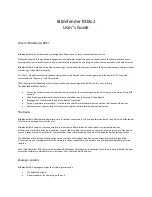
30-9
Cisco Catalyst Blade Switch 3130 and 3032 for Dell Software Configuration Guide
OL-12247-04
Chapter 30 Configuring SPAN and RSPAN
Understanding SPAN and RSPAN
RSPAN VLAN
The RSPAN VLAN carries SPAN traffic between RSPAN source and destination sessions. It has these
special characteristics:
•
All traffic in the RSPAN VLAN is always flooded.
•
No MAC address learning occurs on the RSPAN VLAN.
•
RSPAN VLAN traffic only flows on trunk ports.
•
RSPAN VLANs must be configured in VLAN configuration mode by using the
remote-span
VLAN
configuration mode command.
•
STP can run on RSPAN VLAN trunks but not on SPAN destination ports.
•
An RSPAN VLAN cannot be a private-VLAN primary or secondary VLAN.
For VLANs 1 to 1005 that are visible to VLAN Trunking Protocol (VTP), the VLAN ID and its
associated RSPAN characteristic are propagated by VTP. If you assign an RSPAN VLAN ID in the
extended VLAN range (1006 to 4094), you must manually configure all intermediate switches.
It is normal to have multiple RSPAN VLANs in a network at the same time with each RSPAN VLAN
defining a network-wide RSPAN session. That is, multiple RSPAN source sessions anywhere in the
network can contribute packets to the RSPAN session. It is also possible to have multiple RSPAN
destination sessions throughout the network, monitoring the same RSPAN VLAN and presenting traffic
to the user. The RSPAN VLAN ID separates the sessions.
SPAN and RSPAN Interaction with Other Features
SPAN interacts with these features:
•
Routing—SPAN does not monitor routed traffic. VSPAN only monitors traffic that enters or exits
the switch, not traffic that is routed between VLANs. For example, if a VLAN is being
Rx-monitored and the switch routes traffic from another VLAN to the monitored VLAN, that traffic
is not monitored and not received on the SPAN destination port.
•
STP—A destination port does not participate in STP while its SPAN or RSPAN session is active.
The destination port can participate in STP after the SPAN or RSPAN session is disabled. On a
source port, SPAN does not affect the STP status. STP can be active on trunk ports carrying an
RSPAN VLAN.
•
CDP—A SPAN destination port does not participate in CDP while the SPAN session is active. After
the SPAN session is disabled, the port again participates in CDP.
•
VTP—You can use VTP to prune an RSPAN VLAN between switches.
•
VLAN and trunking—You can modify VLAN membership or trunk settings for source or
destination ports at any time. However, changes in VLAN membership or trunk settings for a
destination port do not take effect until you remove the SPAN destination configuration. Changes
in VLAN membership or trunk settings for a source port immediately take effect, and the respective
SPAN sessions automatically adjust accordingly.
•
EtherChannel—You can configure an EtherChannel group as a source port but not as a SPAN
destination port. When a group is configured as a SPAN source, the entire group is monitored.
If a physical port is added to a monitored EtherChannel group, the new port is added to the SPAN
source port list. If a port is removed from a monitored EtherChannel group, it is automatically
removed from the source port list.














































